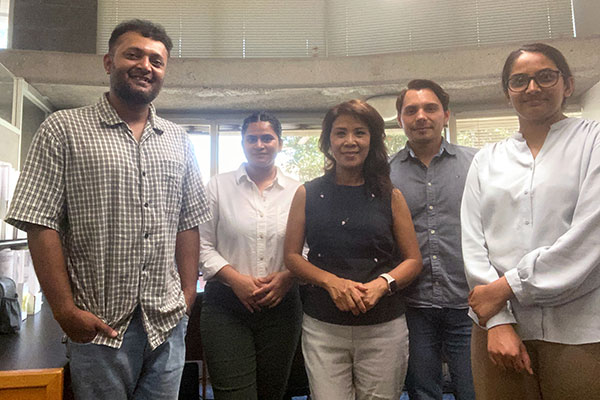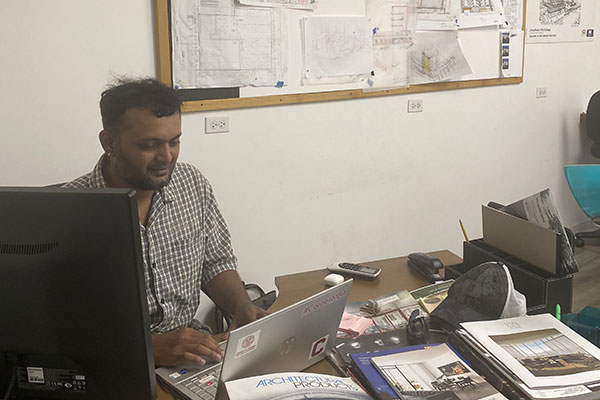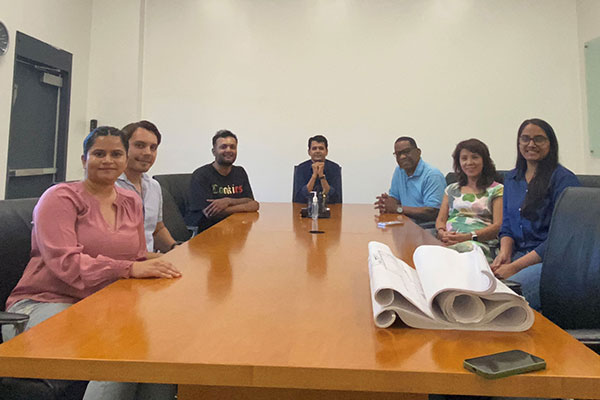Building the Housing Future

Guru Bhardwaj (left) with Brahmbhatt Architects colleagues at their office in Los Angeles, August 2024
During my internship with Brahmbhatt Architects, I found myself at the intersection of social impact, technological innovation, growth, and financial sustainability. My role was multifaceted, involving market research, securing financing, and implementing strategic growth initiatives, all while exploring how technology could be leveraged to optimize costs and improve project feasibility. My work primarily dealt with developing sustainable housing solutions for very low-income (VLI) and homeless populations—a mission that resonates deeply with my commitment to using finance and technology to address societal challenges. I am extremely grateful for receiving the Social Impact Internship Fund (SIIF) from the Center for Sustainable Global Enterprise (CSGE), which allowed me to have this opportunity.
Project overview
At Brahmbhatt Architects, I contributed to these high-impact projects across the housing and development sector, where the application of technological advancements was pivotal:
RSH Development Feasibility:
This 91-unit, mixed-use development project required a comprehensive financial strategy and a technological upgrade to ensure viability. My focus was on researching and procuring both short-term and long-term financing options, as well as exploring technological solutions that could reduce construction costs without compromising quality. I prepared detailed project profiles for potential investors and financiers, highlighting how these technological innovations would enhance both the affordability and attractiveness of the project.
Dev Bravin Development Feasibility:
This 100+ unit, mixed-use development was another key project where technology played a crucial role. I conducted in-depth market research and feasibility assessments, with a particular focus on identifying cost-saving technologies. By integrating smart construction techniques and advanced modeling tools, I was able to propose solutions that not only reduced costs but also improved the overall sustainability of the project.
OMG Hospitality Development Feasibility:
Combining 120 units of mixed-use development with a hotel component, this project required a delicate balance of financial planning and technological integration. My role involved conducting a thorough feasibility study, researching ongoing investment options, and preparing profiles to attract financiers. Here, technology was key in optimizing operational efficiency and reducing long-term maintenance costs, which were critical factors in making the project financially sustainable and socially impactful.

Strategic growth and technological integration
Beyond my work on individual projects, I played a significant role in the strategic growth and technological advancement of Brahmbhatt Architects and its construction arm, AVIN Construction. I undertook a comprehensive review and evaluation of the company’s portfolio and website, identifying key areas where technology could enhance the company’s appeal to investors and partners. This included optimizing the company’s online presence and incorporating digital tools for project tracking and investor communication.
In addition to streamlining operational processes, I contributed to the creation of standard templates that integrated technological tools for project management. These templates helped the company improve efficiency and consistency in its communications with financiers and stakeholders. By leveraging technology, Brahmbhatt Architects was able to cut down costs, making its projects more feasible and attractive to investors. This was a crucial step in positioning the company as a forward-thinking leader in the affordable housing sector.
One of the most significant aspects of my internship was preparing a growth plan for Brahmbhatt Architects and AVIN Construction. This plan not only outlined the company’s strategic direction but also emphasized the role of technological advancements in achieving its goals. By highlighting the potential for both financial returns and social impact using technology, I was able to craft a compelling narrative for investors.

Market research, feasibility assessments, and technological applications
Market research was a cornerstone of my work, with technology playing an increasingly key role. I conducted extensive analyses of demographic data, housing demand, and economic trends, using advanced analytical tools to identify the most promising locations for development. These insights were critical in determining the viability of the projects and in crafting compelling pitches that highlighted the role of technology in reducing costs and enhancing project sustainability.
Feasibility assessments were another key component of my role. These assessments involved evaluating the financial health of the projects, estimating costs, and projecting revenues, all while considering the impact of technological innovations. My research into short-term and long-term financing options was particularly valuable, as it ensured that the projects could be sustainable while still achieving their social objectives. I also explored viability gap funding opportunities, which are crucial in ensuring that projects targeting low-income populations can move forward despite financial challenges.
Fundraising for social impact through technological innovation
A sizeable portion of my internship involved engaging in fundraising efforts that emphasized the role of technology in achieving social impact. I prepared detailed project profiles and growth plans that highlighted both the financial returns and the technological innovations integrated into each project. These profiles were instrumental in attracting investors who were not only interested in profit but also committed to supporting innovative solutions for societal challenges.
In addition to private investors, I worked on securing grant funding for Brahmbhatt Architects’ nonprofit initiatives, which focus on protecting the built environment and raising awareness of social issues through technological means. This aspect of my work reinforced the importance of aligning financial goals with technological advancements and social missions—a balance that is essential in the field of social impact.
Reflections
This internship was a transformative experience that allowed me to apply my skills in market research, financial analysis, and technological integration to real-world projects with tangible social benefits. The work was challenging, particularly in ensuring that the projects were both financially viable and technologically advanced while still achieving their social objectives. However, it was also incredibly rewarding to see how my contributions could help create much-needed housing for vulnerable populations.
One of the key takeaways from this experience is the importance of leveraging technology to optimize costs and enhance project feasibility. It is not enough to focus solely on the financial aspects of a project; one must also consider how technological advancements can drive both efficiency and social impact. This internship reinforced my commitment to pursuing a career where I can continue to work at the intersection of finance, technology, and social good.
About Guru Bhardwaj, MBA ’25

Guru Bhardwaj is a class of 2025 student in the Two-Year MBA program at the Samuel Curtis Johnson Graduate School of Management who is specializing in the intersection of finance, technology, business, and social impact. A recipient of the Social Impact Internship Fund, he worked over the summer with Brahmbhatt Architects, where he integrated advanced technological solutions with strategic growth and financing strategies to enhance the viability of affordable housing projects. He is driven by a passion for creating sustainable solutions for very low-income group and homeless populations.
